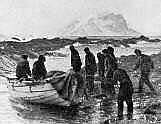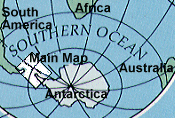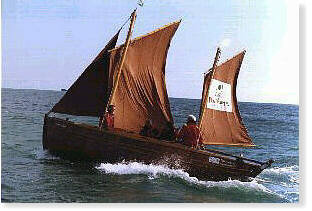
![]()
.
.
.
.

.
.
.
.
.
.
.
.
.
.
.

.
.
.
.
.
.
.
.
.
.
.
.
.
.

![]()

[
Logbook Index ]

Log
Entry for 18/19 January 1997
Position 1200 GMT: 60-40 S 53-50 W
Click
map for detailed position chart showing relative track of James Caird
and Tom Crean
The Tom Crean is on the open ocean today after
successful landings at Cape Valentine and Point Wild yesterday
afternoon. Wind NW 5 - 10 knots.
|
Since putting to sea at 2300 GMT yesterday evening (Jan 18th) the crew has logged 40 miles in the direction of South Georgia. A good start to the 700 mile passage ahead of them. A very strong ridge of high pressure over the Drake Passage gave us ideal conditions yesterday for two landings on historic parts of Elephant Island. On 14 April 1916, the boats James Caird, Stancomb Wills and the Dudley Docker were driven ashore at Cape Valentine and hauled up the rocky beach by the 28 exhausted men who had sailed from the edge of the pack ice five days earlier. The three open boats had become separated and arrived off Elephant Island in gale conditions, the dull light of a early winters afternoon giving them little comfort. Looking at the same cape in the sunshine yesterday, with Pelagic anchored close by in 25 meters, it was easy to appreciate the achievement of getting ashore here. There is no 'easy landing place', a strong current runs through the outlying rocks off the headland and the swell, in spite of the settled weather, was still pounding the shoreline. Patrick and Elena scouted a landing place in amongst some boulders just breaking the surface. The crew of Tom Crean anchored some way off the beach and were then ferried ashore. Fur seals and sea lions guarded the frontage backed by steep cliffs. Some were with pups so we were careful not to disturb them. Although the pups were innocently inquisitive, the parents growled a warning with bared teeth if we wandered within their radius of confidence. These seals are from the family Otaria which means eared seals and they characteristcally have large fore flippers with which they can become quite mobile ashore. Seals are wary on land as it is not their natural environment. There is nothing a beached seal hates more than having an intruder come between him and his ultimate escape route of the sea. Therefore we always try to walk behind them if possible. We found no trace of Shackleton's landing so after a quick inspection we returned to Pelagic and took Tom Crean in tow for the seven mile run west along the north coast to Point Wild. A two knot current pushed us there in short order and we were soon at anchor, in 12 meters, off the celebrated piece of land which Frank Wild found with the Stancomb Wills on April 16th. Wild had been sent on a reconnaissance when Shackleton realised Cape Valentine was untenable as a long term camp. He chose Point Wild as a safe spot for the party to shelter against the seas during northerly gales. Point Wild may have been safe, but it is anything but salubrious! The 'sandy spit' described by Wild is nothing more than a narrow bouldered isthmus. It runs between a steep slope barring access inland and a rocky promontory that is about 20 meters high and marks the end of the point. The whole is no more than 150 meters long. The low part of the spit must be awash in any kind of weather from the northeast. The big difference between our landing on January 18 and Shackleton's arrival on 17th April 1916 is that he had some room to move when he came ashore. By April, the Chinstrap penguin colony, excepting the usual stragglers, would have put to sea for their winter wanderings. Yesterday, we could hardly take a step for the mating pairs and chicks. If you weren't careful they were literally underfoot. They covered every square meter of ground both flat and precipitous and their pink guano made the going slippery and certainly smelly - you either enjoy the smell or you don't! I find it aromatic and after you've been to many of these colonies over the years the aroma is always nostalgic. Chinstraps normally lay two eggs, the chicks, well advanced when we arrived, are downy grey and usually fledge to sea sometime in February. Again, there was no sign of Wild's camp - 80 years of gales and penguins have obliterated all traces of what was home to the 22 men who were left behind when Shackleton, Worsley, Crean, Mcneish, Macarty and Vincent sailed off in the James Caird to South Georgia. Given the nature of the terrain it is hard to imagine just where the camp actually was. It was even harder to imagine how Mcilroy and Macklin amputated the toes of Blackbarrow who had frostbitten feet. This 'operation' was performed under an upturned boat! A new addition to the spit is a bronze bust of Luis Pardo Villadon, the Chilean pilot of the Yelcho, who on 30 Aug 1916, helped Shackleton make his fourth and finally successful attempt to rescue the 22. An interval of four months had passed since Shackleton had said goodbye promising he would be back. The commemorative bust was placed here by the Armada Naval de Chile in January 1988. With Point Wild well photographed and etched into our memories, it was time for the crew of the Tom Crean, like Shackleton, to get on with the job of sailing to South Georgia. There was little wind inshore, but Frank Nugent declared, "no more towing, we're going under our own steam now". So they took to their oars and paddled out a ways to gain a westerly zephyr. In little time they were a speck on the horizon. Before upping anchor to follow them Elena, Patrick, John, Mick and I enjoyed a leisurely meal and gave them a bit of sea room. A critical portion of our support vessel role has been completed by making the landings, but a harder one of tracking the Tom Crean to South Georgia follows. Will the 'luck of the Irish continue?' Skip Novak
|

